Deep Focus: Triple 9
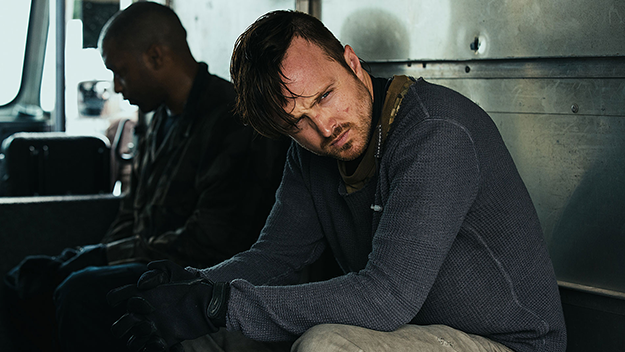
If I didn’t know that Triple 9 is named for an actual police code, I’d bet that director John Hillcoat had simply turned the Satanic number 666 upside down. The Australian director’s movies, at least the four that have opened here—The Proposition (05), The Road (09), Lawless (12), and now Triple 9—don’t merely descend into a Dantean inferno. They start in one. It’s too bad he seldom justifies the tour.
To be fair, Hillcoat has a dogged talent and a knack for sensing when his movie needs some emergency adrenaline. Triple 9 is a good-cop/bad-cop/worse-cop saga about a crackerjack criminal crew made up of ex-servicemen and crooked policemen at odds with their mobster employers; they’re also under attack from a wily, gangster-hating detective working major crimes (Woody Harrelson). Just when you tire of epic stick-’em-ups and corrupt negotiations, Hillcoat stages a nerve-wracking police raid in a public project. It’s so scary that it makes you understand why some cops applaud the militarization of the police. Then Hillcoat brings home the lunacy of sending an armored vehicle and dozens of sharpshooters to the door of an apartment that should sport an “infant inside” sticker. The showdown climaxes in a simple foot race that’s both viscerally satisfying and strategically telling. Unfortunately, sequences like this one stand out like the mammoth towers of a sagging suspension bridge.
Triple 9 contains a challenging concept at its core: police call in a 999—according to policecodes.net, “Urgent help needed / Officer down”—when a fellow officer gets killed. Hillcoat, also one of the film’s producers, has described what attracted him to the movie: the moral complexity of tainted cops using that code to create a diversion for a crime. But he hasn’t found a way to make this quandary reverberate throughout the film, partly because, from the start, you’re already convinced that when it comes to how low these guys will sink, there’s no bottom. Triple 9 works mainly as a state-of-the-art heist film peppered with unhinged shootouts. It’s Heat redone over an uneven flame.
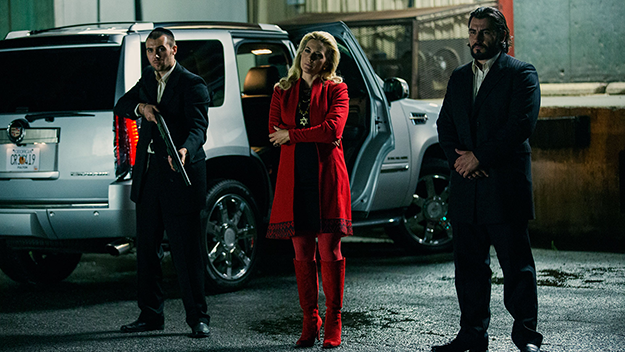
Hillcoat’s most commercial movie yet, Triple 9 features a cavalcade of stars doing their best to add luster to underwritten roles. Working from a process-heavy script by first-time feature screenwriter Matt Cook, Hillcoat chronicles a gang of ex-soldiers and crooked cops who use inside information to implement some intricate and nefarious plans. Led by former elite commando Michael Atwood (Chiwetel Ejiofor) with charismatic wariness, they pull off a risky bank robbery for the haughty Russian-Israeli Mafia queenpin Irina Vlaslov (Kate Winslet). She refuses to fork over their fee until they execute a second, more formidable job: extracting files from a Department of Homeland Security office that will secure the release of her husband from a Russian prison. Michael has a son with Irina’s sister, voluptuous Elena (Gal Gadot, in a role cut down to toothpick-size). His only chance to see his beloved boy Felix is to invade the Atlanta office of the DHS.
Hillcoat doesn’t hand the audience any crucial information: he takes viewers on the storytelling equivalent of a rough ride. He must think that dropping us into the thick of the drama before we get to know his antiheroes will intensify any identification we might have with them. It’s hard to argue that “action is character,” though, when the characters are wearing ski masks. So you must draw your own bead on each of Michael’s not-so-merry men. Hillcoat does give his melodramatis personae a sort of brass-knuckles symmetry: Norman Reedus exudes crisp professionalism as Russel Welch, who monitors the police radio and traffic patterns during stickups, but his ex-cop brother, Gabe (Aaron Paul), is an excitable mess who mucks up the bank heist by grabbing cash. (The group’s target is a safe deposit box.) Gabe’s unruly and unstable, but he also boasts the crew’s sole fully functioning conscience.
Cold-blooded Franco Rodriguez (Clifton Collins Jr.) pushes the idea that their best shot at creating a diversion for the Homeland Security job is to generate a Triple 9—kill a cop, an act that would distract the entire Atlanta force. Gabe can’t believe his criminal band of brothers would take that heartless option seriously. Slick, self-possessed Marcus Belmont (Anthony Mackie) appears ready to pop the trigger. Then he develops affection, respect, and even gratitude for the Triple 9’s intended target: his new partner in the Atlanta gangs unit, Chris Allen (Casey Affleck). Chris just happens to be the nephew of Harrelson’s character, Sergeant Detective Jeff Allen.
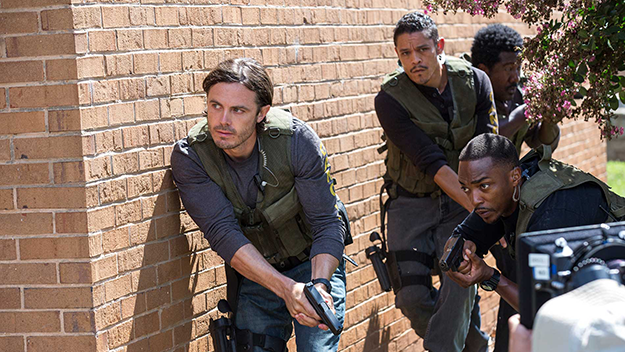
As contemporary directors go, Hillcoat is, as Gilbert and Sullivan would say, “the very model of a modern major general” with “information animal, vegetable, and mineral.” He likes to spread his casts across imposing cityscapes and landscapes in images that boast density as well as scope. He packs each frame with grimy yet illuminating visual data as he obsessively traces spirals of man-made hells: the outlaw terrorism and colonial brutality on the Australian outback in the 1880s (The Proposition), the post-apocalypse as envisioned by Cormac McCarthy (The Road), rural Virginia during Prohibition (Lawless), and now, in Triple 9, the riskiest zip codes in present-day Atlanta. Hillcoat’s eye for design here encompasses the cop-and-crook locations of a big Southern city—a precinct whose ambiance is mid-century suburban, a brick housing complex that would be nondescript were it not for swarms of seething gang members.
Hillcoat generally attracts terrific actors and creates memorable vignettes when he’s not bending, folding, and mutilating their bodies. I’m thinking of Emily Watson tending her fragile flower garden in the desert wastes of The Proposition; Viggo Mortensen opening a dusty can of Coca-Cola to the amazement of young Kodi Smit-McPhee in The Road; and the members of the Church of the Brethren in Lawless—notably fresh-faced Mia Wasikowska—singing hymns with ritual discipline and fervor before moving in strict rows to wash each other’s feet. But Triple 9 contains no room for lyrical asides, not even of the Edward Hopper variety. Its most evocative tableau is Ejiofor’s gang getting slowly drunk on a grungy street where even the neon is burned out.
Like all of these Hillcoat movies, Triple 9 is consumed, not just by blood but also by blood relations. He peoples his stories with close-knit brothers, uncles, nephews, parents, and spouses who are insane or devoted, alternately or at once. Gabe can’t keep mind and body together without his sibling by his side, Michael’s determination to see his son blurs his judgment, and Irina’s devotion to her clan and especially to springing her man from a Russian jail has turned her into the Wicked Witch of the Middle East. In a Hillcoat film, no outsider can cut a family tie. Anyone who mistakes even a comrade-in-arms for an actual brother does so at his peril. “Leave no man behind” might have worked in special ops, but these fellows subscribe to “Take the money and run.”
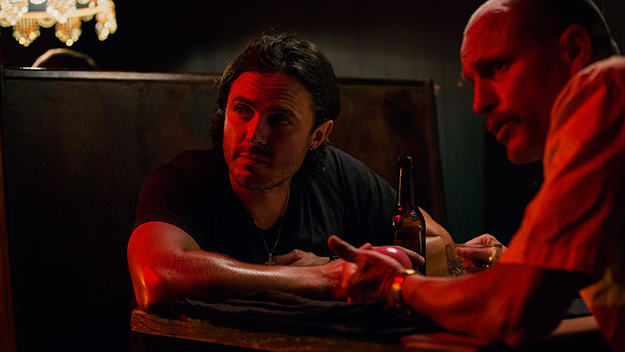
Even the sour and lowdown Triple 9 features a few cathartic splashes of bravura, like red dye exploding from bricks of cash and staining the clothes of the bank robbers. The use of red is one of Hillcoat’s auteur motifs: he counterpoints the color’s association with death with its expression of passionate life. (In Lawless, Jessica Chastain’s red hair is so vibrant it seems like a special effect.) But Hillcoat fails to sustain the intense poetic feeling, the psychological depth, and the resonant mesh of words and images that would make him the heir to Sam Peckinpah, to whom he’s often compared.
The key family unit in Triple 9 is the Allens, partly because Harrelson and Affleck play off each other wackily and beautifully. It’s also the most fleshed-out. Harrelson portrays a police detective as the stoned descendant of the lonely, wised-up 1940s private eye. He feels that in taking down a crook, his job is to “out-monster the monster.” Even Harrelson’s fleeting scenes with Michelle Ang as his go-to pal in the major crimes unit are refreshing and amusing. They conjure a dry rapport: he’s a handful but she knows exactly how to humor him. And Affleck brings mulish urgency to an idealistic guy whose righteous behavior rouses his uncle Jeff’s protective instincts and appalls his colleagues on the gangs squad. Affleck’s Chris seems intent on applying a “broken windows” theory of police-work (punishing minor crimes eventually prevents major ones) even when it comes to facing off against a highly armed brigada. His colleagues consider it a sign of laughable naïveté and a ridiculous risk to get in the face of a gangbanger in an attempt to demand respect.
Dramatically, Triple 9, like most Hillcoat films, functions like an elaborately choreographed scrum from which only the most ruggedly virtuous, such as Chris, emerge more or less unscathed. Chris wears a cross around his neck while the cruel, ultra-materialistic, and racist Irina sports an outsize silver Star of David. If Winslet weren’t so over the top, she might have been offensive. Instead, her stylized fantasy of ballsy female power is both loony and intriguing. Was she giving Hillcoat exactly what he wanted? If so, then perhaps he got carried away seeking a bold, macho female contrast to the male gangsters’ utter conventionality.
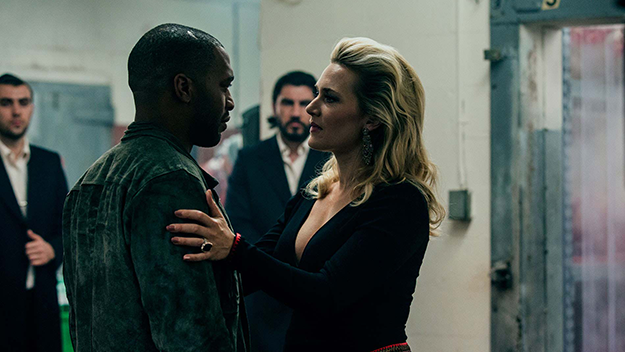
Aaron Paul has said that going to the set for the bank heist was like becoming a kid again and playing “cops and robbers.” The audience gets less enjoyment out of it than he did. Harrelson aside, Triple 9 contains little comedy, and the movie itself has scant vitality. The sad joke surrounding the movie is that Triple 9 keeps Hillcoat’s record for moroseness intact. The grim, gore-splattered ending ensures one thing: the most upbeat and invigorating film on this director’s resume actually remains that pop post-Armageddon, The Road.
Michael Sragow is a contributing editor to FILM COMMENT and writes its Deep Focus column. He is a member of the National Society of Film Critics and the Los Angeles Film Critics Association.







